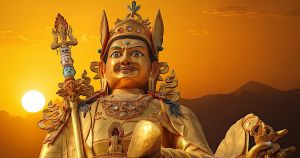Guru Tsengyé: Eight Manifestations of the Precious Teacher
The life of Guru Rinpoche is told in over two dozen books, the most famous of which are the kathang biographies. According to these books, he is said to have lived a life full of miracles that spanned centuries. In Bhutan, his long and colourful life and works are often remembered through the eight chapters of his missions throughout India and the Himalayas. In these retellings, he assumed eight specific identities, each of which has a different name, referred to collectively as tsengyé (མཚན་བརྒྱད་).
He was known as Tsokyé Dorjé (མཚོ་སྐྱེས་རྡོ་རྗེ་) when he was born on the lotus flower in Dhanakośa lake and subsequently adopted by the childless King Indrabodhi of Oḍḍiyāna. As a prince living a luxurious life in the palace, Tsokyé Dorjé longed for the spiritual life of a renunciant. When he could not persuade his father to allow him renounce his princely life, he resorted to outrageous antics and killed a minister’s son. For this, he was banished from the country and he roamed in northern India as an ascetic, adopting different spiritual practices. In order to build his religious credibility, he took full monastic ordination and came to be known as Śākyaseṅge (ཤཱཀྱ་སེངྒེ་).
He continued his religious education at the feet of many teachers and mastered many sciences including medicine, linguistics, alchemy, arts and crafts, earning the name learned Loden Chogsé (བློ་ལྡན་མཆོག་སྲེད་). His training specially focused on the Buddhist science of training the mind using esoteric tantric techniques, which he learnt from many different masters. The name Padmasambhava (པདྨ་འབྱུང་གནས་) is mainly associated with his mastery of these esoteric teachings, which he later transmitted to Tibet and Bhutan as the principal corpus of his legacy.
When he spent time in the charnel grounds practicing some of the esoteric teachings and developing power for performing miracles, he was known as Nyima Özer (ཉི་མ་འོད་ཟེར་) for miraculously preventing the sun from setting. When Bodh Gaya, the holiest Buddhist shrine was taken over by non-Buddhist rivals, he appeared miraculously in a wrathful form to defeat the non-Buddhist opponents in both intellectual and miracle contests. For his role as a defender of the faith, he was given the name Senggé Dradrok (སེང་གེ་སྒྲ་སྒྲོག་), the lion’s roar.
As he traversed the Indian sub-continent to subjugate evil and spread the Buddha’s message of peace, he visited the kingdom of Zahor, where he started a spiritual relationship with princess Mandarava. Outraged by his liaison with the princess, the king had him arrested and burnt alive but he miraculously transformed the fire into a tranquil lake and reappeared with his consort atop a blossoming lotus. The king is said to have repented his ignorance and rash action and offered service to Padmasambhava. The Guru became known as Padma Gyalpo (པདྨ་རྒྱལ་པོ་), the Lotus King.
According to popular accounts, in the final chapter of his life, Guru Rinpoche was invited by the kings of Tibet and Bhutan to subdue the hostile spirits and natural forces of the Himalayan landscape who hindered the diffusion of the Buddha’s teachings. Using his power of the enlightened mind and magic, he is said to have tamed almost all malevolent spirits of the Himalayas and bound them under an oath to follow a non-violent path and serve the Buddhist doctrine. The greatest of his acts of subjugation of local Himalayan deities was carried out by taking up the form of wrathful exuberance, Dorjé Drölö (རྡོ་རྗེ་གྲོ་ལོད་), the last of the eight manifestations.
Although there are many other chapters in his life and epithets he used, the eight characters and chapters of Guru Rinpoche’s life came to be the most popular way of telling his story. Today, Guru Rinpoche’s benevolent life and works are illustrated through these eight characters in both fine art and sacred dances. They remind the devotees of the noble qualities of his enlightened state and his divine mission in the human world.
Karma Phuntsho is the Director of Shejun Agency for Bhutan’s Cultural Documentation and Research, the President of the Loden Foundation and the author of The History of Bhutan. The piece was initially published in Bhutan’s national newspaper Kuensel in a series called Why We Do What We Do.
Source
[[1]]
